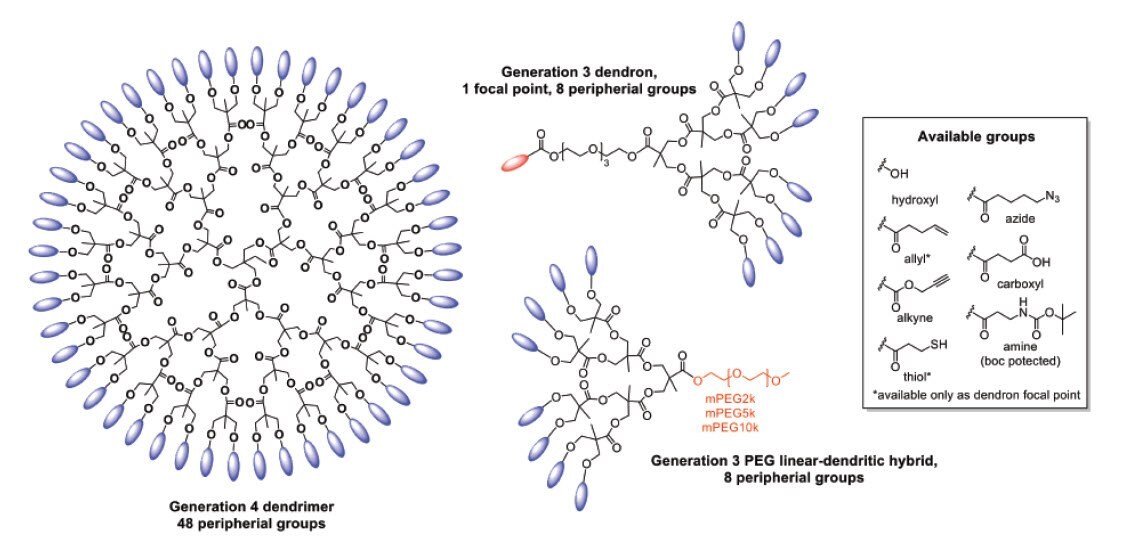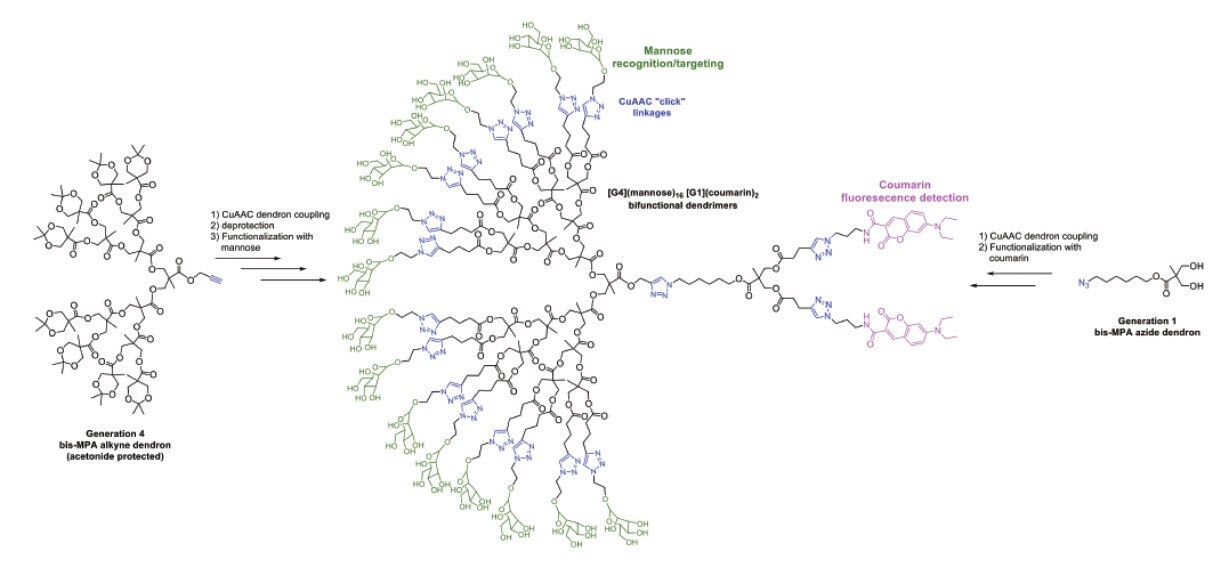The Potential of Dendritic Polyester Scaffolds as Biocompatible Drug Delivery Agents
Dr. Jamie Godfrey1,2, Dr. Michael Malkoch2
1Polymer Factory Sweden AB., 2KTH Royal Institute of Technology
Material Matters™, 2020, 15.3
Introduction/Background
Dendrimers, dendrons, and linear dendritic hybrids comprise a family of synthetic macromolecules containing a large number of branches and, thus, a multitude of peripheral groups. These molecules are constructed in a layer-by-layer fashion, in which each layer is termed a generation. Due to the high degree of control afforded by this approach, and in contrast to the broader family of hyperbranched polymers, true dendrimers exhibit practically defect-free architectures, providing unrivaled control over molecular weight, number of peripheral functional groups, and nanoscale size. This results in unparalleled batch-to-batch consistency. These unique properties have made dendritic polymers attractive candidates for biomedical applications, particularly in the design of drug delivery systems, imaging probes, and the introduction of targeting moieties. As such, dendrimers and dendrons display several advantages over their less well-defined counterparts, including:
- large and exact payload of drug molecules for targeting motifs or other bioactive units due to large and precise number of peripheral groups
- predicable and reproducible structure activity relationships due to batch-to-batch consistency and lack of defects
- inherently modular and customizable structures, both from the ground up and at the periphery, allowing tuning of water solubility and degradation in physiological conditions
- encapsulation of hydrophobic or hydrophilic drugs as a passive delivery system based on a well-defined interior
- ability to combine multiple modes of action in the same carrier, e.g., bifunctional nano-carriers loaded with both drug and imaging probes for visualization of delivery
Types of Dendrimers
Vögtle et al.,1 Newkome et al.,2 and Tomalia et al.,3 pioneered the synthesis of dendrimers, with Tomalia’s contribution leading to the poly(amidoamine), or PAMAM, dendrimers becoming the first commercially available family of dendrimers. PAMAM dendrimer construction occurs via the formation of subsequent amine and amide linkages, with the final macromolecule displaying amino surface groups at the periphery.
PAMAM dendrimers show considerable cytotoxicity to several cell lines,4-6 with their biocompatibility compromised by a relatively hydrolytically stable interior, preventing timely degradation in the body. Additionally, unavoidable side reactions during synthesis often lead to the presence of structural defects, reducing the dendritic purity and precise nature of the molecules. For example, a fourth-generation PAMAM dendrimer may contain only 8% defect-free product.7
Hult, et al. introduced a class of dendrimers with a polyester scaffold in 1996,8 which have since produced an extensive library of multifunctional dendrimers, dendrons, and linear dendritic hybrid block copolymers (Figure 1), many of which are commercially available through MilliporeSigma and Polymer Factory. In contrast to other widely used dendrimers, the family of bis-MPA dendrimers presents low or no in vitro toxicity, no specific in vivo organ accumulation, no immunogenic profile, and are biodegradable under physiological conditions.4,5 Other characteristics that make these molecules attractive for biomedical applications and drug delivery systems include the availability of a range of architectures (e.g., dendrons that present two orthogonal functionalities as linkers and signal amplifiers for molecules of interest), as well as the availability of scaffolds that possess a range of reactive groups for simple modification with a drug or bioactive substrates. The structural perfection attainable with bis-MPA-based dendrimers has been further highlighted by their use as mass spectrometry calibration standards, with no structural defects detected even up to the fifth generation.9 Herein, a highlight of the drug delivery and related applications realized using bis-MPA dendritic materials is presented.

Figure 1.Examples of functional bis-MPA based dendritic structures commercially available through MilliporeSigma.
Bis-MPA Dendritic Scaffolds for Drug Delivery and Targeting
The majority of polymeric drug delivery systems (DDS) can be separated into two categories: passive strategies where the drug is physically entrapped in the interior of a delivery vessel via hydrophobic or ionic interactions, and covalent attachment of drug molecules directly to the polymeric scaffold.
Delivery via Passive Entrapment
Passive encapsulation strategies using dendritic polymers have primarily been based on one of two approaches: (1) formation of micelles and other nanostructures with amphiphiles based on bis-MPA linear-dendritic block copolymers, or (2) modification of dendritic structures with a hydrophilic corona, allowing water solubility while maintaining a hydrophobic interior for loading of non-polar cargo such as drug molecules.
The groups of Nyström and Malkoch evaluated both poly(ethylene glycol) (PEG) linear-dendritic hybrids and their less well-defined hyperbranched analogs as micellar carriers of anticancer drugs.10 The authors observed that the carriers before drug loading showed no dose-dependent toxicity toward the cancer cell lines tested, while the therapeutically loaded micelles increased the efficacy vs the free drug. Subsequently, Malkoch, Hawker et al. expanded on this work, utilizing the bifunctional nature of PEG bis-MPA linear-dendritic hybrids to construct fluorescent-tagged, supramolecular self-assemblies of nanoscale size.11 The nano-carriers were loaded with nearly 20 wt % of doxorubicin (DOX) and triptolide (TPL), increasing the therapeutic efficacy for both drugs, as well as their combinations, against human breast cancer cell lines. Additionally, the fluorescent tag afforded by the precision nature of the liner dendritic structure allowed intracellular tracking of the nano-carrier, elucidating the mechanism of improved action at a cellular level. Frechet et al. also used PEG linear dendritic hybrids to form DOX loaded micelles with acetal groups at the hydrophobic termini, allowing disruption of the micelles and triggering release under mildly acidic condition.12 These pH-responsive nano-carriers were designed for the controlled release of the chemotherapeutic agent at the elevated pH of tumor sites.
Malmström, Nyström, et al. demonstrated an alternative approach, whereby the formation of core-shell nanoparticles occurred spontaneously by controlled radical polymerization of oligo(ethylene glycol) methacrylate monomer from multifunctional dendritic initiators.13 Through the incorporation of fluorinated co-monomer, dual functional theranostic nanoparticles were obtained, capable of passive loading with DOX and other hydrophobic drugs, as well as imaging via19 F- MRI. The authors observed controllable drug release kinetics noted the possibility to tune the release profile through variation of the dendritic hydrophobic segment.
PAMAM and poly(propylene imine) (PPI) dendrimers have emerged as promising candidates as non-viral gene delivery vectors in gene therapy. The polycationic nature of these macromolecules allows them to bind to nucleic acids at physiological pH.14 However, PAMAM and PPI dendrimers are highly stable in physiological solution, preventing degradation of the carrier and preventing safe clearance from the body.5 Malkoch et al. recently reported that bis-MPA dendrimers could be modified with beta-alanine peripheral groups, providing a polycationic macromolecular structure, analogous to those of PAMAM, while maintaining a polyester interior capable of rapid degradation under biologically relevant conditions.15 The amine functional polyester dendrimers displayed an increase in neurotoxicity compared to the neutral bis-MPA scaffolds, but a lower neurotoxicity than commercially available PAMAM dendrimers. These molecules were further evaluated as nonviral vectors for siRNA delivery:16 G2 to G4 dendrimers bearing 12 to 48 amino end-groups were capable of siRNA complexation and subsequent protection of siRNA from degradation by RNase, leading to a 20% decrease of target protein expression.
Delivery via Covalent Attachment
Due to the hydrophobic nature of many pharmaceutically active compounds, covalent attachment to biocompatible polymeric scaffolds is an attractive method for increasing aqueous solubility, introducing active or passive targeting for desired cells/tissues and tuning of the release profile. Dendritic frameworks based on bis-MPA are versatile structures for covalent attachment of drug molecules: they are commercially available with a range of reactive groups easily manipulated via efficient chemistries, possess several peripheral groups for increased payloads or additional targeting/imaging moieties, and also can include orthogonal reactive groups for dual functional delivery systems. The range of available methods for drug attachment also allows for the tailoring of the linking chemistry to further control the release of active drugs through external stimuli, such as pH or the reductive potential of a cell.
The dual-functionality possible with bis-MPA scaffolds was exploited by Fréchet et al. to construct “bow-tie” bifunctional dendrimers with pH-sensitive linkages at one face, and multiple PEG chains at the other to provide aqueous solubility and optimized blood circulation time.17 This dendrimer DDS gave a nine-fold increase in specific tumor uptake compared to a free drug in a colorectal animal model. Sharpless, Hawker et al. utilized a similar approach of bifunctional dendrimer design, to produce dendrimers containing exact numbers of mannose units for recognition/targeting, along with coumarin for detection through fluorescence (Figure 2).18 The dendrimers showed a 240-fold increased potency for the inhibition of hemagglutination. A critical advantage of coupling functional dendrons to give dual-functional “bow-tie” dendrimers lies in the absolute control that can be achieved through a modular synthesis. High batchto- batch consistency can be achieved with good optimization of linking chemistry, allowing carriers with exact numbers of each functional moiety; this is in stark contrast to methods of adding multifunctional units to a pre-existing carrier in a statistical manner, which unavoidably leads to an undefined mixture unlikely pass regulatory revision and translate to the clinic.19

Figure 2.Synthetic scheme showing the construction of bifunctional dual-purpose recognition/detection dendrimers. Adapted with permission from reference 18, copyright 2005 Royal Society of Chemistry
Bifunctional dendrons based on bis-MPA have great potential for the linking of drugs, diagnostic probes, or bioactive molecules to tailor or improve their properties. Their bifunctional nature allows simple covalent attachment of molecules of interest at the core, with orthogonal peripheral groups providing a broad and exact number of further chemical handles to tailor solubility or other desired properties further. Valliant, Adronov et al. introduced a tridentate ligand capable of forming stable complexes with 99mTc to bis-MPA dendrons of generations 4 through 7, creating radiolabeling probes.20 The subsequent in vivo SPECT imaging revealed that the dendrimers were cleared from the body of the rats within 15 minutes, with no retention in any organ. The authors noted that the study enables further investigation of targeting via surface functionalization in further studies. Ellis-Davies et al. utilized a similar strategy to introduce water solubility and avoid unwanted GABA receptor antagonism of chemical probes for two-photo optoneurobiology.21 The authors conjugated generation 4 and 5, alkyne focal point dendrons to a series of probes via CuAAC “click” chemistry, allowing for the study of the signaling of GABA in its natural state for the first time. Another example of the attachment of imaging probes to a dendritic scaffold, has been demonstrated by the attachment of fluorescent dyes to the periphery of bis-MPA dendrons allowing dual-functional therapeutics with imaging capability.22 The authors introduced multiple, exact numbers of Cy5 dye to the surface of generation 1 to 3 dendrons, and showed that generation 3 dendrons amplified the fluorescent signal vs the lower generation dendrons and a monofunctional control. A chemoselective focal point was retained in the molecules, allowing labelling of an antibody without jeopardizing activity.
Functionalization Strategies for Commercially Available bis-MPA Dendrons
The wide range of commercially available polyester dendrimer and dendrons allows the development of new macromolecules tailored to specific drug delivery targets. These can be fabricated by exploiting several efficient and straightforward chemical modifications, ideally operating in an orthogonal manner and avoiding the use of protecting chemistry. Development of conjugation chemistries over the past two decades based on “click” chemistry principles,23 are presented in Table 1. Such chemistries have been used for the conjugation of a diverse range of biologically active substrates to bis-MPA scaffolds, including PEG,10,24 sugar units,18 drug molecules,17 biotin25 and fluorescent probes.22
Summary
Dendrimers, dendrons, and linear-dendritic hybrids are among the most sophisticated materials available to scientists aiming to deliver and enhance the effect of biologically active molecules. Due to their precise and modular nature, along with a range of efficient conjugation chemistries, countless iterations of advanced DDS frameworks are now possible. The commercial availability of these structures may provide non-specialist chemists the toolbox to build the next generation of drug delivery systems.
References
To continue reading please sign in or create an account.
Don't Have An Account?